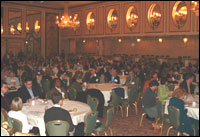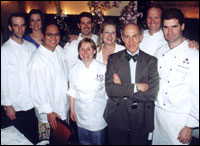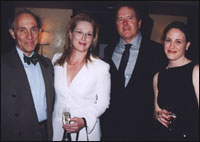Kathleen Frith manages communications and outreach for the Center for Health and the Global Environment at Harvard Medical School. An American-Bermudian, she previously worked at the Bermuda Biological Station for Research.

Monday, 31 Mar 2003
BOSTON, Mass.
It’s the beginning of a marathon week. This Friday night our Center is holding a fundraiser in New York City, next week we’re holding our two-day annual course for congressional staffers, and on April 28 we’re presenting Jane Goodall with our annual Global Environmental Citizen Award in Boston. In addition, I keep checking reports and commentary about the U.S. conflict in Iraq in a somewhat vain attempt to comprehend how our country has arrived in our present situation and what will likely be the short-term and long-term consequences of a “preemptive” strike. Today’s focus is Friday night.
Meryl Streep, who has been in touch with the Center and our work for the past few years, agreed to host a fundraiser and asked Sigourney Weaver to accompany her. Both of them are dedicated environmentalists — Meryl formed the group Mothers and Others for a Livable Planet in 1989 to educate people about the possible effects of pesticides on children’s health and she has worked with a number of other organizations promoting awareness about the threat to our health caused by toxins. Sigourney Weaver played Dian Fossey in the seminal work “Gorillas in the Mist,” which illustrated the importance of habitat preservation. Sigourney is on the board of the Dian Fossey Institute and has also worked with Natural Resources Defense Council and other organizations to raise awareness about these issues. Both dedicated mothers, they are particularly interested in the human health connection to the environment, which is the basis of the Center’s mission.
Working with artists has always been an important aspect of my work. I see all artists — actors, musicians, writers, painters, etc. — as our society’s most poignant storytellers. They have the gift of stirring our emotions and activating change. In my view, environmental stories, especially the stories that capture human health connections to our changing environment, need artists to make their urgency felt. Especially now.
For the event Friday night, we have been working with a number of New York’s finest chefs and celebrity Iron Chef Moriomoto. The concept is that food is a perfect, tangible illustration of the intersection between human health and environmental health. The chefs will be creating a fantastic four-course meal made from organic produce, sustainable seafood stocks, and responsibly raised livestock. Even the wine for each course is made from organic grapes. Working with these chefs has also been a great source of inspiration. Many of these chefs are working on unique, effective environmental programs — one chef is designing organic and sustainable food for Delta’s new airline Song, set to launch later this month. The Center is striving to create a thoughtfulness of behavior — where people do not simply pick up their groceries without thinking about what chemicals might have been added that may pose health threats, how the product was harvested, and how those practices affect health.
If all goes well, the event on Friday will be full of hope and will provide an outlet for a group of artists, chefs, scientists, politicians, CEOs, and environmentalists to come together and inspire each other. This congregation of so many diverse backgrounds with a common thread of interest is one of the most rewarding aspects of my work here at the Center. I think it will also provide an opportunity for thinkers to commune during this time of such conflict.
Recently, the Center published a report on the human health effects of oil, from extraction through to combustion. The negative effects of oil and the ties with this country’s leadership and international policies are indisputable, exemplified by Halliburton waiting in the conflict’s wings in a Kuwait City hotel readying to get its hands on billions of barrels of reserve oil. I am anxious to attend a conference hosted by the Coalition for Environmentally Responsible Economies in New York tomorrow to hear what corporations such as Ford and GM are doing to help our economy transition to renewable energy.
Tuesday, 1 Apr 2003
NEW YORK, N.Y.
Up at 5:30 this morning to catch the shuttle from Boston to New York City for the Coalition for Environmentally Responsible Economies conference. I’m always surprised at the gender gap on the shuttle, a frequent commute for business people on the East Coast. It’s usually about 90 percent men in suits (although I did notice a bit more fleece than usual today). The ratio is surely some proxy of the lingering inequalities in the professional world, and it always serves to strengthen my resolve to work toward more recognition for women’s skills and contributions in the professional realm.
The ultra-tight security also captures my attention. Before falling asleep last night, the idea of purchasing my own gas mask crossed my mind. Upon reflection, I realize I am slipping into the same mindset I had as a kid in the 1980s about the threat of a nuclear war. Now, as an adult raising my own daughter, I’m not sure which I fear more — an actual attack or the prevailing sense of fear that is now woven into the fabric of our society.
In any case, my cab driver and I made it past the Manhattan check points and to the conference. In the past few years, I have begun treading (albeit lightly) in the corporate world. I came in with the somewhat naive and narrow-minded perspective of an idealistic environmentalist (“can’t we all just work together and save the environment?”), but I have realized that it is foolish to blindly follow one’s ideals without an acute awareness of the myriad obstacles to and consequences of doing so. Economics is one very important piece of the picture of our current environmental threats and potential solutions.

The CERES conference gets down to business.
Photo: CERES.
The sheer power of big business in this country and internationally is so great that one is left feeling that large corporations will have to lead the way to a healthy environment by adopting environmentally responsible practices. At a time when I have been utterly disgusted by corporate greed and lies, I have also been introduced to large (mostly foreign) companies that seem to genuinely recognize the value of environmental responsibility — and by value, I mean both the social/moral value and the very tangible bottom-line value.
This morning, I attended a workshop about “green lodging” — hotels, cities, and meeting planners that take environmental issues such as energy use, water use and waste into account in their work. Once again, I was delighted to hear from people who are happy to report stronger profits, better PR, and happier employees thanks to reducing energy waste, serving organic food, using environment- and health-friendly cleaning supplies, and taking part in community efforts to conserve the environment. The message this morning, as it has been at every CERES event I have attended, is that good environmental practices equals good business.
Wednesday, 2 Apr 2003
BOSTON, Mass.
My time at the Coalition for Environmentally Responsible Economies conference yesterday was informative, and provided a “shot in the arm” through hearing what other groups and individuals are doing to protect the environment. My afternoon workshop discussed the World Summit on Sustainable Development, held last year in Johannesburg, South Africa, and progress that’s been made since then. The group discussed the value of large, multilateral policies about the environment and the pros and cons of such huge summits. Overall, I left feeling like these summits, while rife with organizational flaws, provide an incentive to governments and corporations around the world to face these issues and create policies to address them.
What is most upsetting about the international pressure for environmental agreements is my own nation’s stubborn non-participation. Someone at the workshop said that even modest wording in the Plan of Implementation at Johannesburg was rejected in deference to anticipated U.S. resistance. It seems that the Bush administration is totally satisfied with a go-it-alone policy and does not value international consensus with regard to a range of issues.
One of the most compelling remarks at the conference was made by a union representative for U.S. Steelworkers. He spoke of the union’s long involvement with environmental issues, and especially with the human-health consequences of pollutants commonly found in his industry. He pointed out, however, that in order for a real transition to cleaner energy to occur, the burden of those industry workers must be taken into account. Simply put, no one will trade in his or her livelihood unless there are other employment options. He pressed all of us to find innovative and real options for these workers as we move forward in our quest for cleaner technology.
I took the shuttle back to Boston early this morning and have been working all day on press releases for the event on Friday. One would think Meryl Streep and Sigourney Weaver would attract the press easily enough, but I am having to work the phones quite a bit. Most reporters and editors are glued to the Iraq conflict and a good-news celebrity event does seem a bit out of place.
In addition, we are working on the giveaway bags for the event, which include a great deal of information about organic and environmentally responsible food. We hope the event will be a major educational opportunity and that the guests will feel empowered to know that their personal choices can make a huge difference.
Thursday, 3 Apr 2003
BOSTON, Mass.
It’s a bit crazy here in the office due to preparations for our Friday night event. Like many environmental nonprofits, we have a small shop and all of us work on a range of tasks, so I can go from drafting remarks for our event to stuffing goodie bags with organic seeds and mini-planters.
I am hoping to attract some press to our event in an effort to raise awareness about the human-health connection to the environment. Many of the responses I am getting are from reporters not interested in organic food, but rather in the new mystery illness, SARS. Although people are asking about the environmental connections, it is too early to begin to piece together all the underlying causes of the disease.
Our center — and especially our associate director, Paul Epstein — works on a number of climate connections to infectious diseases such as malaria and West Nile Virus. The spread of West Nile, which killed over 100 people in the U.S. last year, may be caused by the changing climate’s effect on the mosquito that spreads the disease. Mosquitoes need warm weather to survive, and the rising temperatures can increase their range. The heat can also speed up their metabolisms, producing more generations of mosquitoes in a single season. The extreme weather events brought on by climate volatility can also increase the number of mosquitoes, since heavy rains after drought conditions can create standing water, prime breeding ground for mosquitoes.
It is so often the case that the media simplifies these stories, when in my opinion, the complexities are far more interesting. Here is a prime example: Right now, an Ebola epidemic has swept through the Congo, killing hundreds of gorillas and chimpanzees (our closest relatives) and over 100 people. The epidemic has spread through the handling of bushmeat, illegally hunted primates. This is also thought to be the way that HIV spread, since HIV originated from SIV, the chimpanzee form of the disease.
One of the factors that increases the bushmeat trade is deforestation and loss of habitat, which makes these animals vulnerable to poachers. So, it is not simply that we are losing these precious animals whose numbers are already dangerously low; it is that we are endangering our own lives when we tamper so destructively with their habitat.
Friday, 4 Apr 2003
NEW YORK, N.Y.
I am back in New York City preparing for tonight’s big event — last-minute press releases to go out, goodie bags to stuff, remarks to polish, seating to assign, and so forth.

Dan Barbe, Sigourney Weaver, Masaharu Morimoto, Michael Anthony, Susan Lifreiri, Meryl Streep, Eric Chivian, Michel Nischan, Kerry Heffernan.
One thing I’m really looking forward to about tonight is the food. The chefs have worked really hard to come up with a fantastic menu with all-organic, local produce — a serious challenge in New York this time of year. The first sit-down course will be prepared by Morimoto, a chef on the cult Food Network show “Iron Chef” who has just opened his own restaurant in Philadelphia. True to his Japanese style, he is preparing a raw course of hook-and-line-caught cod. Awareness about the importance of choosing seafood from sustainable stocks has flourished in recent years, thanks in large part to groups like Chef’s Collaborative and ocean-education institutions like the Monterey Bay Aquarium and the Audubon Society. We recently received a Seafood-Lover’s Almanac from the Audubon’s Living Oceans program, which I highly recommend to anyone interested in this issue. It is comprehensive, up-to-date, and beautifully illustrated.
As part of my work at the center, I am collaborating with the New England Aquarium on an exhibit about how the health of the oceans affects human health. We hope to show people that the oceans play a vital role in human health and that if we threaten the health of the ocean, we threaten our own health — and the health of our children. When we first started this program, a colleague of mine and I stationed ourselves outside the aquarium and asked visitors to name one way the ocean affects their health. Ninety percent of people said they did not know. The other 10 percent named seafood as a link between their health and the health of the oceans, but even most of those people were not aware of the contamination issues, such as mercury, that compromise the otherwise very significant nutritional value of seafood.

Eric Chivian, Meryl Streep, Don Gummer (Meryl’s husband), and Kathleen Frith.
Our exhibit will explore direct links such as seafood contamination (and the disturbing fact that nursing infants are the most vulnerable to such pollutants), but it will also explore less direct human health impacts of the ocean, such as how changes in the climate will affect the oceans, and in turn affect human health. Rising seas due to melting glaciers and thermal expansion are one of the largest human-health threats the world now faces. The small island nation of Tuvalu in the South Pacific has already begun evacuating its people due to the impact of sea-level rise. These 11,000 people may constitute global warming’s first environmental refugees, but unless mitigation occurs quickly and aggressively, they will be followed by many more. Rising seas contaminate small islands’ already-limited freshwater supply with salt water, and the extreme weather events associated with global warming will further compromise the health and safety or islanders.
The great irony of this situation, of course, is that the people who live on these islands bear the brunt of global environmental problems for which they are not responsible. The same is true for native population living in pristine arctic environments that are being polluted by toxins blown in on wind and ocean currents from other places.
These are the issues I hope I can bring into the common dialogue, so we can start to make the transition from one of the world’s largest polluters to a leader in remediation. It is up to us, to every one of us, to voice our collective outrage so that together we can push for saner, healthier national and international policy.

